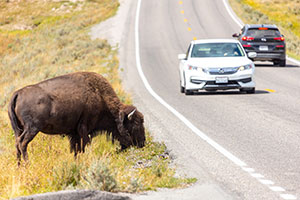
Wildlife-vehicle collisions (WVC) can cause motorist fatalities, injuries, and property damage to vehicles. One way to reduce the risk of these collisions is through the use of wildlife exclusion fence in conjunction with wildlife crossing structures. To ensure that wildlife utilize crossing structures rather than crossing at grade, wildlife fence is used to guide animals to the structures or to safer crossing locations. Wildlife fence in combination with crossing structures has been determined to be the most effective and robust strategy to improve human safety through reducing collisions with large mammals, and to provide safe crossing opportunities for wildlife. Deterring wildlife from entering the "highway side" of the fence and addressing wildlife end-runs of the fence are important considerations in proper implementation of this strategy. Although wildlife fence is effective in reducing WVC, limited research is available on the effectiveness of state-of-the-art technology fence end treatments such as electrified wildlife deterrent mat systems installed at the fence ends to prevent wildlife from entering the "highway side" of the fencing.
This research will study the effectiveness of embedded electrified concrete mat in deterring wildlife from entering the fenced road corridor; wildlife behavior at the mats and the end of the fencing; and the performance of the wildlife deterrent mats under various environmental conditions. The research will use analytic software and thermal imaging to recognize wildlife and trigger video recording. This is an important component of the research as the research focuses on the roadway and screening the traffic vehicles from animal movement is critical to efficient and accurate analysis. Video clips will allow researchers to conduct qualitative and quantitative data analysis of the interaction between wildlife, roads, and electrified mats. Imaging would observe wildlife behavior at a) the right of way (approach to the road), b) the roadway, and c) the electrified mat.
Scope of Work
Project Overview
For more information, contact
